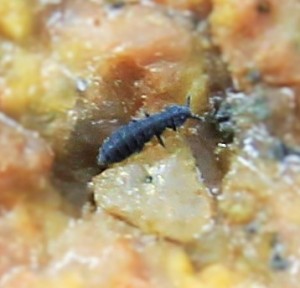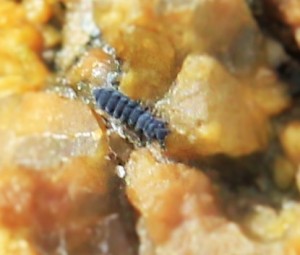Yesterday (8/9/2015), while walking the shore off the cottage during low tide, I stopped to rest on a boulder. I scanned the gravel, stones, shells, and other debris that becomes exposed when the water recedes. At my feet lay a conglomerate mass of sand and small stones. This mass appeared to have formed when gravely debris became embedded in the glutinous secretions of filamentous alga and silt. The detrital ball, about the size of my fist, will become cemented together by a variety of processes and harden over many years to form the conglomerate stones found on ocean beaches.
“Once a biologist, always a biologist. Damn, one should never allow a retired marine ecologist beach combing privileges.”
I picked up the mass, examined it, and found that the granules could easily be broken off. So this conglomerate seemed to be in its early stage of creation. Hyphae of a white mold formed a dendritic network over and through the moist area (underside) of the mass, which suggested the granules were still being bound together by an organic matrix. Also, after chipped off some grains, little millimeter-sized, gray, cylindrical organisms scooted around looking for cover. These I easily identified as some sort of insect. At first glance these little bugs looked like lice. But, no. Lice are very light colored and obligate parasites on mammals, birds, plants and other living things. Whatever these bugs were, they were feeding on the organic stuff in the gravel ball.
When Marian came by with her camera, she took some close-up photos of the mass, hoping that one of the photos might capture one of these little insects. And—three cheers for the photographer—the insects were photographically documented.
Though the extreme magnification made the images a little fuzzy, they were sufficient to ID the bugs as members of the insect Order Collembola that could possibly be in one of the following taxonomic groups: Ceratophysella, Hypogastura, or Proisotoma that are found in the U.S.A.
This is an order of small primitively wingless arthropods that are related to, or sometimes classed among the true insects. They have 6 abdominal segments, 3 pairs of legs, antennae, and sometimes a forked caudal furcula. Collembolans are found everywhere, especially in soil rich in organic debris, in rotting logs, on the surface of snow or water, and (a characteristic most important to me) in the intertidal zone—where I found them. Collembolans are commonly known as springtails. But the ones I found did not us their springer (an appendage found under the first abdominal segment called a collophore) that they can use to escape. Instead these little gray bugs scooted into crevices that separated the granules.
Collembolan-like fossils have been found in material dating back 400 million years, so the group is considered by some to be very ancient. Other taxonomists think they evolved more recently as an offshoot of the true flies Order Diptera. Presently there is very little known of the biology and evolution of this group of organisms.
The exciting thing for me is that I found an insect in a saltwater environment, a place where insects are rare—except for the Diptera. There may be more out there than we know. Because of their extreme primitiveness, it is highly possible they can tolerate oceanic waters, and live quite happily in the intertidal zone.
Well back to the beach. Perhaps I’ll find something a little less crawly.
ʃ ʃ ʃ ʃ
© Copyright 2015 Richard Modlin
© Copyright Photographs 2015 Marian Moore Lewis
Check out Marian Moore Lewis’ recent book Southern Sanctuary, which contains many of her excellent nature photos. Southern Sanctuary is available from Amazon.com.



Very good blog article.Really thank you! Really Great.
By: satta matka live satta matka on August 17, 2023
at 8:58 am
Excellent blog you have got here.. It’s difficult to find good quality writing like yours nowadays. I really appreciate people like you! Take care!!
By: Roseanne Wool on January 26, 2020
at 6:33 am
very interesting and the photos are great
By: William Waters on August 11, 2015
at 4:41 pm